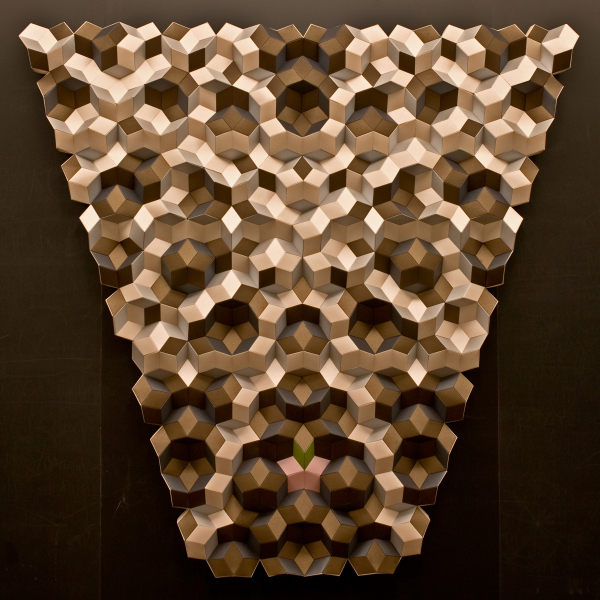
Mathematical ImageryMathematical artists create strong, stunning works in all media and explore the visualization of mathematics
2021 Mathematical Art Exhibition
The 2021 Mathematical Art Exhibition was held virtually during the Joint Mathematical Meetings in January. Here on Mathematical Imagery are recipients of the 2021 Mathematical Art Exhibition Awards: "Laura’s Flowerpot," by Debora Coombs and Duane Bailey, awarded Best textile, sculpture, or other medium; "Eight-Ring Circus," by Margaret Kepner, awarded Best photograph, painting, or print; and "Recontstruction," by Phillip Webster, Honorable Mention. The award "for aesthetically pleasing works that combine mathematics and art" was established in 2008 through an endowment provided to the American Mathematical Society by an anonymous donor who wishes to acknowledge those whose works demonstrate the beauty and elegance of mathematics expressed in a visual art form.

Best Textile, Sculpture, or Other Medium by Debora Coombs and Duane Bailey
"This sculpture is a patch of Penrose tiling raised into the third dimension. It is built from a single shape, a golden rhombus orientated according to its equivalent self in two-dimensions. If the tiling were to begin growing with the small pink and green cluster of tiles (lower center) the orientation of all dark tiles could be predicted to infinity. The orientation of the lighter colored tiles cannot. This is based upon the work of Laura Effinger-Dean who, in 2006, developed algorithmic methods for determining which tiles may be predicted to infinity. Viewed obliquely, the tiling appears disordered. Stereopsis makes it hard to see the classic Penrose. But shifting viewpoints reveal new sightlines and rhythmic sequences of tiles." This is made from 137 x 137 x 10 cm folded pearlescent cardstock, 2018. See an example here.

Best Photograph, Painting, or Print by Margaret Kepner
"A partition of N is a set of positive integers that adds up to N. This work is an exploration of the 22 unique partitions of eight, and their representations and properties. For example, the diagram located in row 4, column 2 of the left-hand block depicts the partition 3 + 3 + 1+ 1. The number of sectors corresponds to the number of terms (4), and in each sector the number of rings represents the values of the terms 3, 3, 1, and 1. This diagram can be 3-colored. In the right-hand block, the roles of sectors and rings are reversed. Thus, the diagram for the same partition (displayed in the corresponding position) is shown using 4 rings that have subdivisions of 3, 3, 1, and 1 (working inward). In this format, the diagram must be 4-colored." This is a 50 x 50 cm archival Inkjet Print, 2020. See an example here.

Honorable Mention by Phillip Webster
"This work is a manual re-creation of an especially elegant two-level Islamic geometric pattern found at the Madrassa Madar-i-Shah in Isfahan, Iran. The piece was drawn using nothing but pencil, straightedge, and compass. One half is fully complete and colored, while the other was left partially constructed to highlight the construction process. On the left the larger, top-level pattern -- a well-known pattern based on 5- and 10-fold symmetry -- is visible. These lines were widened, and then smaller versions of the same 10-pointed star are fit precisely into the widened bands and the reduced tiles in between. The tile shapes in both the small and the large pattern (before widening) are identical, making this pattern truly self-similar. " This is a 50 x 40 cm created with pencil and marker, 2019. See an example here.
These and other works in various mediums submitted to the JMM 2021 Mathematical Art Exhibition may be found here.



